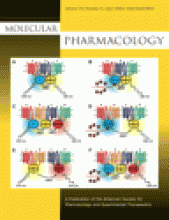Abstract
Several therapeutic compounds have been identified that prolong the QT interval on the electrocardiogram and cause torsade de pointes arrhythmias not by direct block of the cardiac potassium channel human ether-à-go-go-related gene (hERG) but via disruption of hERG trafficking to the cell surface membrane. One example of a clinically important compound class that potently inhibits hERG trafficking are cardiac glycosides. We have shown previously that inhibition of hERG trafficking by cardiac glycosides is initiated via direct block of Na+/K+ pumps and not via off-target interactions with hERG or any other protein. However, it was not known how pump inhibition at the cell surface is coupled to hERG processing in the endoplasmic reticulum. Here, we show that depletion of intracellular K+—either indirectly after long-term exposure to cardiac glycosides or directly after exposure to gramicidin in low sodium media—is sufficient to disrupt hERG trafficking. In K+-depleted cells, hERG trafficking can be restored by permeating K+ or Rb+ ions, incubation at low temperature, exposure to the pharmacological chaperone astemizole, or specific mutations in the selectivity filter of hERG. Our data suggest a novel mechanism for drug-induced trafficking inhibition in which cardiac glycosides produce a [K+]i-mediated conformational defect directly in the hERG channel protein.
Footnotes
-
This work was supported by National Institute of Health National Heart, Lung, and Blood Institute [Grant HL71789] and the Canadian Institutes for Health Research.
-
ABBREVIATIONS: hERG, human ether à-go-go-related gene; IKr, rapidly activating delayed rectifier K current; acLQTS, acquired long QT syndrome; ER, endoplasmic reticulum; HEK, human embryonic kidney; WT, wild type; HA, hemaggultinin; HAex, extracellular hemagglutinin tag; DMEM, Dulbecco's modified Eagle's medium; pHi, intracellular pH; MEM, minimal essential medium; sf, serum-free; Ch, choline chloride; NMDG, N-methyl-d-glucamine; AM, acetoxymethyl ester; BCECF, sodium binding benzofuran isophthalate 2′,7′-bis(carboxyethyl)-5(6′)-carboxyfluorescein; PBFI, K+ binding benzofuran isophtalate; BN, blue native; PAGE, polyacrylamide gel electrophoresis; ROS, reactive oxygen species; NAC, N-acetyl cysteine; MAP, mitogen-activated protein; MEK, mitogen-activated protein kinase kinase; ERK, extracellular signal-regulated kinase; PD98059, 2′-amino-3′-methoxyflavone; fg, fully glycosylated; cg, core glycosylated; U0126, 1,4-diamino-2,3-dicyano-1,4-bis(methylthio)-butadiene; SP600125, anthra [1,9-cd]pyrazol-6(2H)-one-1,9-pyrazoloanthrone; SB203580, 4-(4-fluorophenyl)-2-(4-methylsulfinylphenyl)-5-(4-pyridyl)1H-imidazole; H89, N-[2-(4-bromocinnamylamino)ethyl]-5-isoquinoline; KT5720, (9S,10S,12R)-2,3,9,10,11-hexahydro-10-hydroxy-9-methyl-1-oxo-9,12-epoxy-1H-diindolo[1,2,3-fg:3′,2′,1′-kl]pyrrolo[3,4-i][1,6]benzodiazocine-10-carboxylic acid hexyl ester; dn, dominant negative; P, peak; BAPTA, 1,2-bis(2-aminophenoxy)ethane-N,N,N′,N′-tetraacetic acid.
-
↵
 The online version of this article (available at http://molpharm.aspetjournals.org) contains supplemental material.
The online version of this article (available at http://molpharm.aspetjournals.org) contains supplemental material. - Received November 28, 2008.
- Accepted January 12, 2009.
- The American Society for Pharmacology and Experimental Therapeutics
MolPharm articles become freely available 12 months after publication, and remain freely available for 5 years.Non-open access articles that fall outside this five year window are available only to institutional subscribers and current ASPET members, or through the article purchase feature at the bottom of the page.
|







